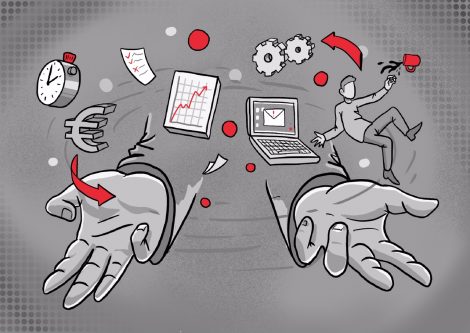HR departments (hardly) influence the ambidexterity of organizations

The concept of organizational ambidexterity has been on everyone’s lips for some time. It refers to the ability of organizations to efficiently exploit existing market opportunities, and at the same time to successfully line themselves up for future challenges by exploring possible innovations (Patel, Messersmith & Lepak, 2013). As early as 15 years ago, research showed that ambidextrous companies produce significantly more disruptive innovations than traditional ones (O’Reilly & Tushman, 2004). Many personnel strategists also try to increase the ambidexterity of their departments by setting up HR innovation units. But are such efforts even relevant for companies as a whole? Or, to put it another way: does HR have a significant influence on the ambidexterity of entire organizations?
By Arne Reis
The concept of organizational ambidexterity has been researched at many universities around the world since the publication of a groundbreaking essay by Stanford professor James Gardner March (1991). Researchers distinguish between structural and contextual ambidexterity. Initially, science assumed that strong efficiency and radical innovation only fit under the umbrella of one organization if they were structurally separate, i.e. based in different business units or functional areas (Tushman & O’Reilly, 1996). Later, the conviction developed that managers and employees should be empowered to focus on either exploitation or exploration depending on the context of specific tasks (Gibson & Birkinshaw, 2004).
Positive tension between efficiency and innovation
A core element of contextual ambiguity is the so-called stretch, meaning the positive tension between efficiency and innovation within an organizational unit (Gibson & Birkinshaw, 2004). This tension particularly arises when employees’ performance targets become more demanding, since in this situation employees have to handle their core business even more efficiently while developing develop new solutions at the same time. This is where HR comes in. Using a data set of around 130 employees at an Israeli bank, study carried out in 2015 examined how various performance management components influenced employee behaviour. It proved that highly qualified members of the organization felt a stronger stretch and achieved significantly higher targets if they were paid ex post performance-based bonuses. For less qualified employees, on the other hand, this was not the case – their performance did not improve in the prospect of potential bonus payments (Ahammad, Lee, Malul & Shoham, 2015).
A Spanish study from the same year looked at the impact of HR products on the ambidexterity of employees and organizations. The study was based on data from around 200 companies in various sectors. The researchers found that employees in all functions behaved significantly more “ambidextrous” and thus more adaptable to new market requirements when HR departments in their companies offered high-involvement HR products (Prieto-Pastor & Martin-Perez, 2015). Individual feedback meetings with managers, continuous internal learning opportunities and bonus payments linked to individual or company results were among the most effective tools.
Best adapted to the environmental conditions
Based on these results, a more recent study from 2019 implicitly assumes that personnel work can influence the ambiguity of entire organizations. Hansen, Güttel and Swart pose the question of how HR departments can make this influence even more effective. In their theoretical study, they come to one central conclusion: HR architectures should be optimally adapted to the environmental conditions in which the respective overall organization operates. Recruiting and personnel development in “high-velocity markets” (e.g. biotechnology) worked completely differently than in “moderately dynamic markets” (e.g. public sector and retail) (Hansen, Güttel & Swart, 2019).
What are the practical implications of these results? First of all, one central conclusion is that HR departments can provide important support in “ambidexterity training” for organizations. As an enabling function, HR ideally provides a framework that motivates, empowers and incentivizes people to live ambidexterity. However, a framework of well-coordinated HR solutions is, at best, a necessary condition for this. It can have an impact on how employees distribute their time and attention between exploitation and exploration (Gibson & Birkinshaw, 2004). Many other factors, however, also contribute to the degree of ambidexterity that ultimately shows in an organization. These include managerial support (Prieto-Pastor & Martin-Perez, 2015) as well as employees’ individual skill levels (Ahammad, Lee, Malul & Shoham, 2015).
HR experts should not only ask themselves how much ambidexterity they can realistically expect from people in their organization, but also to what degree they want to act as role models themselves. A structurally ambidextrous HR organization, in which administrative day-to-day operations and innovation-oriented projects are clearly separated from each other is often easier to implement as a first step. A contextually ambidextrous HR organization, on the other hand, entails more challenging requirements concerning the flexibility of individuals and teams. The motto here is, “Ideally, everyone knows how to do everything”. If leaders and teams opt for this more advanced structure, this requires a well-established culture of dealing with mistakes. After all, the tolerance for mistakes can significantly vary within one team based on the context in which a specific task is performed (Hansen, Güttel & Swart, 2019).
Sources:

